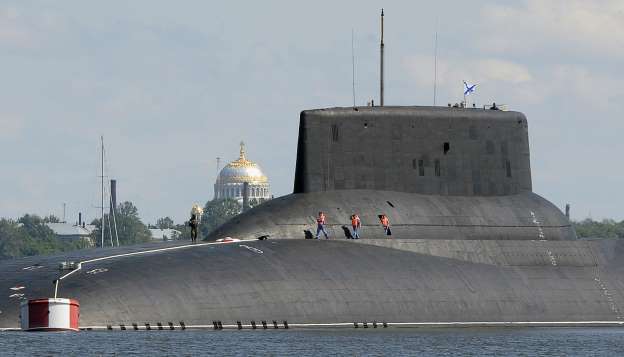Russian submarines have dramatically stepped up activity around undersea data cables in the North Atlantic, part of a more aggressive naval posture that has driven NATO to revive a Cold War-era command, according to senior military officials.
The apparent Russian focus on the cables, which provide Internet and other communications connections to North America and Europe, could give the Kremlin the power to sever or tap into vital data lines, the officials said. Russian submarine activity has increased to levels unseen since the Cold War, they said, sparking hunts in recent months for the elusive watercraft.
“We are now seeing Russian underwater activity in the vicinity of undersea cables that I don’t believe we have ever seen,” said U.S. Navy Rear Adm. Andrew Lennon, the commander of NATO’s submarine forces. “Russia is clearly taking an interest in NATO and NATO nations’ undersea infrastructure.”
NATO has responded with plans to reestablish a command post, shuttered after the Cold War, to help secure the North Atlantic. NATO allies are also rushing to boost anti-submarine warfare capabilities and to develop advanced submarine- detecting planes.
Britain’s top military commander also warned that Russia could imperil the cables that form the backbone of the modern global economy. The privately owned lines, laid along the some of the same corridors as the first transatlantic telegraph wire in 1858, carry nearly all of the communications on the Internet, facilitating trillions of dollars of daily trade. If severed, they could snarl the Web. If tapped, they could give Russia a valuable picture of the tide of the world’s Internet traffic.
“It’s a pattern of activity, and it’s a vulnerability,” said British Air Chief Marshal Stuart Peach, in an interview.
“Can you imagine a scenario where those cables are cut or disrupted, which would immediately and potentially catastrophically affect both our economy and other ways of living if they were disrupted?” Peach said in a speech in London this month.
The Russian Defense Ministry did not respond to a request for comment about the cables.
The Russian sea activity comes as the Kremlin has also pressed against NATO in the air and on land. Russian jets routinely clip NATO airspace in the Baltics, and troops drilled near NATO territory in September.
Russia has moved to modernize its once-decrepit Soviet-era fleet of submarines, bringing online or overhauling 13 craft since 2014. That pace, coming after Russia’s annexation of Ukraine’s Crimean peninsula set off a new era of confrontation with the West, has spurred NATO efforts to counter them. Russia has about 60 full-size submarines, while the United States has 66.
Among Russia’s capabilities, Lennon said, are deep-sea research vessels, including an old converted ballistic submarine that carries smaller submarines.
“They can do oceanographic research, underwater intelligence gathering,” he said. “And what we have observed is an increased activity of that in the vicinity of undersea cables. We know that these auxiliary submarines are designed to work on the ocean floor, and they’re transported by the mother ship, and we believe they may be equipped to manipulate objects on the ocean floor.”
That capability could give Russia the ability to sever the cables or tap into them. The insulated fiber-optic cables are fragile, and ships have damaged them accidentally by dragging their anchors along the seabed. That damage happens near the shore, where it is relatively easy to fix, not in the deeper Atlantic, where the cost of mischief could be far greater.
NATO’s hunts — which have stretched across the Baltic, Mediterranean and Atlantic — have mobilized submarine-tracking frigates, sonar-equipped P8 Poseidon planes and helicopters, and attack submarines that have combed the seas.
“The Russians are operating all over the Atlantic,” said NATO Secretary General Jens Stoltenberg. “They are also operating closer to our shores.”
Russia’s enhanced submarine powers give urgency to NATO’s new efforts to ensure that it can get forces to the battlefront if there is a conflict, Stoltenberg said. In addition to the new Atlantic-focused command, the alliance also plans to create another command dedicated to enabling military forces to travel quickly across Europe.
NATO defense ministers approved the creation of the commands at a November meeting. Further details are expected in February. The plans are still being negotiated, but they currently include the North Atlantic command being embedded inside the U.S. Fleet Forces Command in Norfolk, which would transform into a broader NATO joint force command if there was a conflict, a NATO diplomat said, speaking on the condition of anonymity to discuss plans that have not been finalized.
“Credible deterrence is linked to credible reinforcement capabilities,” Stoltenberg said. “We’re a transatlantic alliance. You need to be able to cross the Atlantic.”








